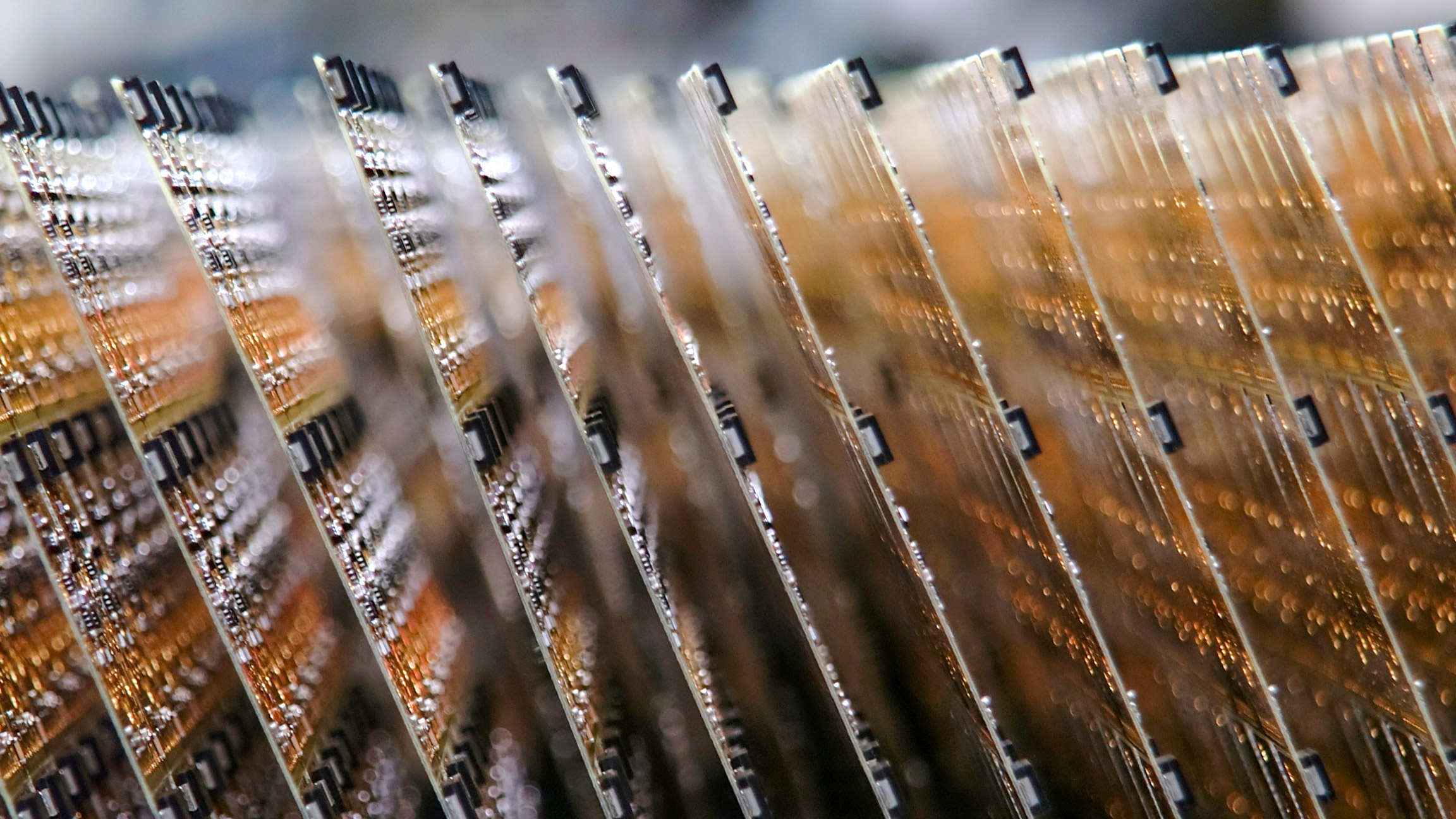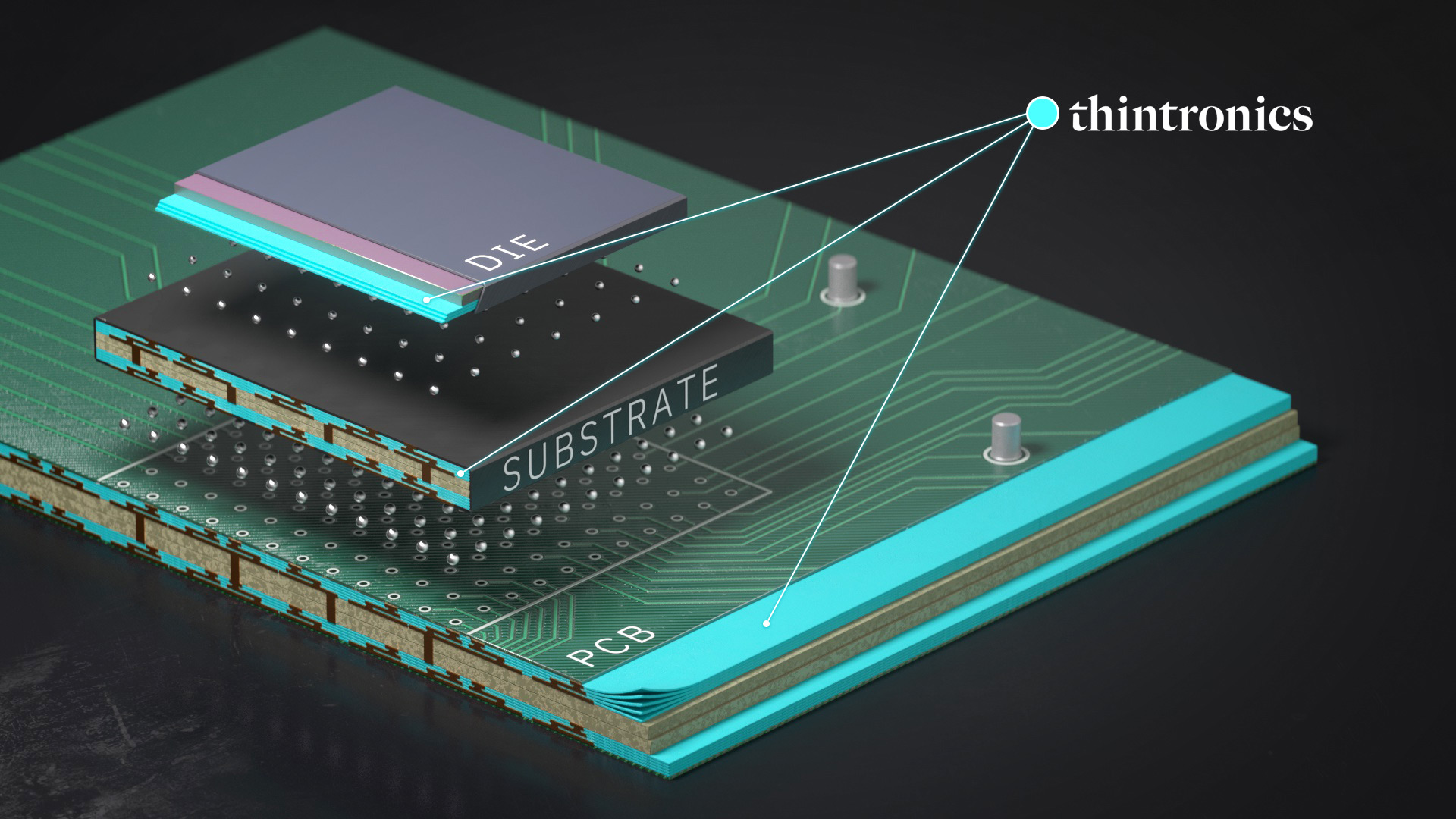This US startup makes a crucial chip material and is taking on a Japanese giant
Federal funding is spurring US companies like Thintronics to disrupt semiconductor manufacturing. Success is far from guaranteed.

It can be dizzying to try to understand all the complex components of a single computer chip: layers of microscopic components linked to one another through highways of copper wires, some barely wider than a few strands of DNA. Nestled between those wires is an insulating material called a dielectric, ensuring that the wires don’t touch and short out. Zooming in further, there’s one particular dielectric placed between the chip and the structure beneath it; this material, called dielectric film, is produced in sheets as thin as white blood cells.
For 30 years, a single Japanese company called Ajinomoto has made billions producing this particular film. Competitors have struggled to outdo them, and today Ajinomoto has more than 90% of the market in the product, which is used in everything from laptops to data centers.
But now, a startup based in Berkeley, California, is embarking on a herculean effort to dethrone Ajinomoto and bring this small slice of the chipmaking supply chain back to the US.
Thintronics is promising a product purpose-built for the computing demands of the AI era—a suite of new materials that the company claims have higher insulating properties and, if adopted, could mean data centers with faster computing speeds and lower energy costs.
The company is at the forefront of a coming wave of new US-based companies, spurred by the $280 billion CHIPS and Science Act, that is seeking to carve out a portion of the semiconductor sector, which has become dominated by just a handful of international players. But to succeed, Thintronics and its peers will have to overcome a web of challenges—solving technical problems, disrupting long-standing industry relationships, and persuading global semiconductor titans to accommodate new suppliers.
“Inventing new materials platforms and getting them into the world is very difficult,” Thintronics founder and CEO Stefan Pastine says. It is “not for the faint of heart.”
The insulator bottleneck
If you recognize the name Ajinomoto, you’re probably surprised to hear it plays a critical role in the chip sector: the company is better known as the world’s leading supplier of MSG seasoning powder. In the 1990s, Ajinomoto discovered that a by-product of MSG made a great insulator, and it has enjoyed a near monopoly in the niche material ever since.
But Ajinomoto doesn’t make any of the other parts that go into chips. In fact, the insulating materials in chips rely on dispersed supply chains: one layer uses materials from Ajinomoto, another uses material from another company, and so on, with none of the layers optimized to work in tandem. The resulting system works okay when data is being transmitted over short paths, but over longer distances, like between chips, weak insulators act as a bottleneck, wasting energy and slowing down computing speeds. That’s recently become a growing concern, especially as the scale of AI training gets more expensive and consumes eye-popping amounts of energy. (Ajinomoto did not respond to requests for comment.)
None of this made much sense to Pastine, a chemist who sold his previous company, which specialized in recycling hard plastics, to an industrial chemicals company in 2019. Around that time, he started to believe that the chemicals industry could be slow to innovate, and he thought the same pattern was keeping chipmakers from finding better insulating materials. In the chip industry, he says, insulators have “kind of been looked at as the redheaded stepchild”—they haven’t seen the progress made with transistors and other chip components.
He launched Thintronics that same year, with the hope that cracking the code on a better insulator could provide data centers with faster computing speeds at lower costs. That idea wasn’t groundbreaking—new insulators are constantly being researched and deployed—but Pastine believed that he could find the right chemistry to deliver a breakthrough.

Thintronics says it will manufacture different insulators for all layers of the chip, for a system designed to swap into existing manufacturing lines. Pastine tells me the materials are now being tested with a number of industry players. But he declined to provide names, citing nondisclosure agreements, and similarly would not share details of the formula.
Without more details, it’s hard to say exactly how well the Thintronics materials compare with competing products. The company recently tested its materials’ Dk values, which are a measure of how effective an insulator a material is. Venky Sundaram, a researcher who has founded multiple semiconductor startups but is not involved with Thintronics, reviewed the results. When compared to other build-up films—the dielectric category in which Thintronics is competing—their most impressive Dk values are better than those of any other material available today, he says.
A rocky road ahead
Thintronics’ vision has already garnered some support. The company received a $20 million Series A funding round in March, led by venture capital firms Translink and Maverick, as well as a grant from the US National Science Foundation.
The company is also seeking funding from the CHIPS Act. Signed into law by President Joe Biden in 2022, it’s designed to boost companies like Thintronics in order to bring semiconductor manufacturing back to American companies and reduce reliance on foreign suppliers. A year after it became law, the administration said that more than 450 companies had submitted statements of interest to receive CHIPS funding for work across the sector.
The bulk of funding from the legislation is destined for large-scale manufacturing facilities, like those operated by Intel in New Mexico and Taiwan Semiconductor Manufacturing Corporation (TSMC) in Arizona. But US Secretary of Commerce Gina Raimondo has said she’d like to see smaller companies receive funding as well, especially in the materials space. In February, applications opened for a pool of $300 million earmarked specifically for materials innovation. While Thintronics declined to say how much funding it was seeking or from which programs, the company does see the CHIPS Act as a major tailwind.
But building a domestic supply chain for chips—a product that currently depends on dozens of companies around the globe—will mean reversing decades of specialization by different countries. And industry experts say it will be difficult to challenge today’s dominant insulator suppliers, who have often had to adapt to fend off new competition.
“Ajinomoto has been a 90-plus-percent-market-share material for more than two decades,” says Sundaram. “This is unheard-of in most businesses, and you can imagine they didn’t get there by not changing.”
One big challenge is that the dominant manufacturers have decades-long relationships with chip designers like Nvidia or Advanced Micro Devices, and with manufacturers like TSMC. Asking these players to swap out materials is a big deal.
“The semiconductor industry is very conservative,” says Larry Zhao, a semiconductor researcher who has worked in the dielectrics industry for more than 25 years. “They like to use the vendors they already know very well, where they know the quality.”
Another obstacle facing Thintronics is technical: insulating materials, like other chip components, are held to manufacturing standards so precise they are difficult to comprehend. The layers where Ajinomoto dominates are thinner than a human hair. The material must also be able to accept tiny holes, which house wires running vertically through the film. Every new iteration is a massive R&D effort in which incumbent companies have the upper hand given their years of experience, says Sundaram.
If all this is completed successfully in a lab, yet another hurdle lies ahead: the material has to retain those properties in a high-volume manufacturing facility, which is where Sundaram has seen past efforts fail.
“I have advised several material suppliers over the years that tried to break into [Ajinomoto’s] business and couldn’t succeed,” he says. “They all ended up having the problem of not being as easy to use in a high-volume production line.”
Despite all these challenges, one thing may be working in Thintronics’ favor: US-based tech giants like Microsoft and Meta are making headway in designing their own chips for the first time. The plan is to use these chips for in-house AI training as well as for the cloud computing capacity that they rent out to customers, both of which would reduce the industry’s reliance on Nvidia.
Though Microsoft, Google, and Meta declined to comment on whether they are pursuing advancements in materials like insulators, Sundaram says these firms could be more willing to work with new US startups rather than defaulting to the old ways of making chips: “They have a lot more of an open mind about supply chains than the existing big guys.”
This story was updated on April 12 to clarify how the Dk values of Thintronics’ materials compare to those of other build-up films.
Deep Dive
Computing

How to break free of Spotify’s algorithm
By delivering what people seem to want, has Spotify killed the joy of music discovery?

AI’s growth needs the right interface
Enough with passive consumption. UX designer Cliff Kuang says it’s way past time we take interfaces back into our own hands.

Move over, text: Video is the new medium of our lives
We are increasingly learning and communicating by means of the moving image. It will shift our culture in untold ways.

African farmers are using private satellite data to improve crop yields
A number of farmers are turning to space-based monitoring to get a better picture of what their crops need.
Stay connected
Get the latest updates from
MIT Technology Review
Discover special offers, top stories, upcoming events, and more.